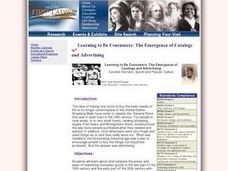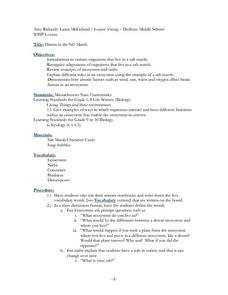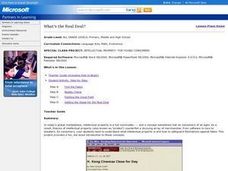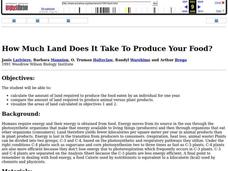Curated OER
Biodiversity in an Estuary
Students investigate the biodiversity in estuaries. In this estuary lesson plan, students use Google Earth to explore the Rookery Bay National Estuarine Research Reserve. They produce a biodiversity concept map and portray the life of a...
Curated OER
Transfer of Energy
In this transfer of energy worksheet, students complete a graphic organizer that shows the relationship between the sun, producers, first order consumers and second order consumers. They describe why it is important to understand the...
Curated OER
Mini-Ponds
In this mini pond worksheet, students create a mini-pond ecosystem with soil, water, and plant life. Students let their ecosystem sit for a day and they observe a sample the next day. Students identify all the pond water microorganisms...
Curated OER
Ecosystems at School
In this ecosystem worksheet, students use a string and make a large circle. Everything in the circle is part of the ecosystem the students will study. They identify everything in their ecosystem and classify their data. They answer 2...
Curated OER
Texas Ecoregions Summary Sheet
In this ecoregions of Texas worksheet, students complete a summary of a particular ecoregion in Texas. They find the producers and consumers of the region, they draw a food chain, the draw a food web, and they complete an energy pyramid...
Curated OER
Interdependence and Adaptation
Fifth graders construct a food web to illustrate how animals and plants are interdependent. In this interdependence instructional activity, 5th graders identify how consumers, producers, herbivores, carnivores and predators are related...
Curated OER
Energy Through the Ecosystem
In this ecosystem activity, students use a diagram of an ocean-based food web to complete 5 short answer questions about the energy flow through this ecosystem.
Curated OER
Plankton
Students explore how to collect plankton and use microscopes to observe and identify it. They collect the plankton sample and classify the various components of the plankton. Students identify organisms in the plankton and draw...
National First Ladies' Library
Learning to Be Consumers: The Emergence of Catalogs and Advertising
Learners study the historical context of marketing and how it came to be so important in the 19th century. They analyze advertising in the 19th century, 20th century, and today to understand how much or how little has changed.
Curated OER
Consumerism - Grocery Shopping
Students watch a video on how marketers plan their strategies in supermarkets. In groups, they are given a set amount of money and asked to go through a grocery store simulation with a list. After the simulation, they discuss the...
Curated OER
The Science and Technology of Food
Students examine the guidelines the United States Department of Agriculture places on food. In groups, they create a list of the foods they consume and discuss the political and environmental implications of purchasing the food. They...
Curated OER
Counting on Cooperatives
Students are introduced to the study of economics, including an introduction to basic business types and systems. They investigate about international, national and California history as they take a historical tour of cooperatives and...
Curated OER
Drama in the Salt Marsh
Middle schoolers are introduced to the various organisms that live in a salt marsh. They recognize adaptations of organisms that live in the salt marsh. Pupils review concepts of the ecosystem and niche. Students explain the different...
Curated OER
First Grade Economics Unit
First graders begin by studying the differences between a "good" and a "service". They compare items to each other to help comprehend the differences. They also look into the differences between buyers and sellers and how the choices...
Curated OER
Producer to Consumer Fun
Students research about producers and consumers. They examine how products become available to consumers and participate in one of the activities listed such as: tour a farm or a factory, go on a scavenger hunt at a local store, or have...
Curated OER
Ecosystem Interactions in Refuges
Seventh graders, using national parks as models, illustrate the energy flow in ecosystems. Working in groups, they use murals, flow charts, or other visual displays to record their findings. Students represent the food chains and webs...
Curated OER
Can We Be Both Conservationists and Consumers?
Students explore their role as consumers and conservationists and what roles they play in today's economic climate. They explore resource allocation issues. Students analyze data and draw comparisons between historical and present-day...
Curated OER
Name Brands
Learners explore the possibility that a products name might bias a consumers decision to buy a particular product. The question remains to be answered, "Why do consumers buy what they buy and why that particular product?"
Curated OER
What's the Real Deal?
Students investigate product counterfeiting and its impact on the US economy. They research product counterfeiting on the Internet then create a "fakes" fact sheet about a specific group of products such as music cods or beanie babies.
Curated OER
How Much Land Does It Take To Produce Your Food?
Students calculate the amount of land required to produce the food eaten by an individual for one year. They compare the amount of land required to produce animal versus plant products. Students visualize the areas of land calculated.
Curated OER
What Did It Cost 100 Years Ago?
Students compare prices of good across the century in order to introduce the topic of inflation. They undertand the concepts of inflation and Consumer Price Index (CPI), use online calculators to figure the approximate cost of goods...
Curated OER
Habitats
Students complete food chains for organisms in three environments. They use copies of the Habitat worksheet. Students review the food chain terms with the teacher. They research related food chains, and interlink these to form a food...
Curated OER
Food Chains
Fourth graders study food chains, producers, consumers, and decomposers. They play a food chain game and create food chain mobiles or posters. They take a nature hike around the school and observe various parts of a food chain.
Curated OER
How Credit Cards Work
Young scholars discuss the nature and use of credit cards. They view a video about the role of credit cards and the whole idea of consumer credit. They examine the benefits and disadvantages to both merchants and consumers.

























